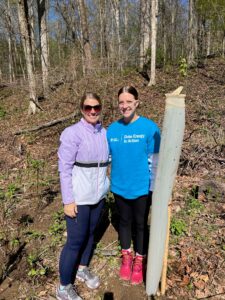Those seeking to make a difference this Earth Day can sign up to support a volunteer-led project orchestrated by the Lake Monroe Water Fund. The project kicked off earlier this month in the form a stake-planting event, where 11 members of the local community planted 600 willow stakes along erosion-prone areas of Clay Lick Creek. This weekend, the second phase of the project will take place with around 900 native trees and shrubs set to be planted in an area beside the creek, once again by the hands of volunteers.
The end-goal for the effort is reflected in its name — the Healthy Woodlands for Clean Drinking Water project. Lake Monroe Water Fund
Executive Director Michelle Cohen said via email last week that the project will remediate soil erosion along Clay Lick Creek and lessen
storm water runoff entering the creek. “The ultimate objective is to reduce the amount of sediment flowing into the north fork of Salt Creek that eventually empties into Lake Monroe,” she said. “We are seeking approximately 80 volunteers to help plant the trees and shrubs
over the course of two days.”
No experience is needed, and volunteers must be at least 8 years old. Holes for the plants will be pre-dug by a machine, and volunteers will work to plant a 1- to 3-gallon container tree or shrub in each hole and fill in the loose soil. Deer browse guard will also be placed around each plant, and each guard will be attached to a stake. Parking is available on-site at the event, which is at CYO Camp Rancho Framasa, and
carpooling is encouraged. Volunteers are also encouraged to bring their own gloves and shovels if they have them, and wear clothes and shoes appropriate for the weather and the work.
The fund will provide snacks, water and a lunch platter for before or after shifts, the website said. Volunteers will also receive a free reusable water bottle and T-shirt courtesy of Duke Energy. The Healthy Woodlands for Clean Drinking Water effort is also serving as a pilot project. Cohen said the fund plans to use what they learn from it to secure funding and investments in similar projects down the line.
“We envision helping property owners implement a number of solutions in the future, like wetland restoration, trail stabilization, or planting native vegetation as buffers beside streams,” she said.
A crucial effort
According to Cohen, the trees and shrubs that were chosen for planting carefully and intentionally. Once the willows are rooted, she said, they will help hold the soil and reduce erosion, and native trees and shrubs do a better job of slowing down and soaking up storm water before it reaches the creek than the current shallow-rooted vegetation. Cohen said a district conservationist with the Natural Resources Conservation Service of the U. S. Department of Agriculture provided technical expertise about the appropriate type of plants to install. “For establishing vegetation to hold the soil on eroded streambanks, they recommended cuttings of a type of willow (the “StreamCo” variety of Salix purpurea),” she said.
Cohen explained that planting the cuttings is as simple as sticking them in bare areas of soil, ensuring that half of the length of the cutting is in the ground. This process, she said, is sometimes called “live staking.” Particular species of trees and shrubs were selected in consulta-
tion with the supplier and with Wagner Forestry. In addition to the water quality benefits, the native plants will provide habitat and food for pollinators and other animals, Cohen said. For example, the fund, with the help this weekend’s volunteers, will plant pagoda dogwood, which has flowers that attract butterflies and berries that feed many species of birds.
Growing conditions and site parameters also influenced plant selection, Cohen said. For example, more shrubs and shorter trees were selected rather than tall trees to avoid any interference with overhead power lines. Cohen explained that the project is vital to the future
health of Lake Monroe, which she said has an “outsized role” in the regional community. The body of water serves as the sole drinking water source for 150,000 customers, supports businesses that generate nearly $6.4 billion in gross domestic product, supports all kinds of recreation and provides critical wildlife habitat, she said. “Reducing sediment — as we aim to do with this project – is crucial to maximize the lake’s lifespan and usability,” she said.
Cohen added that an estimated 35,000 tons of sediment ends up flowing into the lake annually, and settles before it has a chance to exit.
“So the more we can prevent sediment from flowing into the lake, the better,” she said. According to Cohen, sediment can not only slowly decrease the capacity of reservoirs like Lake Monroe, but it also degrades water quality ion a number of ways: by carrying “nutrients” that can feed blue-green algae which in turn release toxins that can make people coming in contact with the water sick; by increasing taste and odor problems, leading to higher costs to treat drinking water; by clouding water, keeping animals from seeing food, and aquatic plants
from growing; and by destroying habitats and causing declines in fish populations. “Added benefits to this project include improvement to wildlife/pollinator habitat, increased carbon storage, and educational opportunities for hundreds of camp guests annually,” she said.
The location that was chosen for the planting was also carefully considered by the fund. The work is being completed on the property of Catholic Youth Organization Camp Rancho Framasa, a local youth camp that has been operating on 297 acres since 1946. The camp is open and offers programming year-round, but according to co-director Kevin Sullivan, the summer camp is their “main gig,” welcoming be-
tween 1,200 and 1,500 kids every summer. About 5,000 people visit CYO through the other nine months, he said. The camp offers school
programs mainly focused on things like outdoor education, teambuilding and leadership development. Sullivan said one of the camp’s core values is stewardship of the earth. That value can be found in action in many of the camp’s conservation efforts, including the installment of owl boxes and bat houses on the property, as well as their 30-year agreement with The Nature Conservancy, called the Forest Bank.
Over the course of the ForestBank’s 30-year life span, the conservancy will help the camp manage invasive species and audit their trees, Sullivan said. One of the LMWF board members is a forestry professional and knew of several properties within the watershed that might
need help with erosion control. Cohen said that CYO was one of the locations suggested, and camp staff wound up being “very receptive” to the project and were able to accommodate the time frame. “The camp already had some wildlife initiatives … so this project was a natural fit, and it has been a delight to work with them,” she said.
“It’s important to us as an education piece, but it’s also important as, you know, that’s one of our core values,” Sullivan said about the project taking place on the camp’s property. According to Cohen, “It’s a perfect way to spend Earth Day!”


